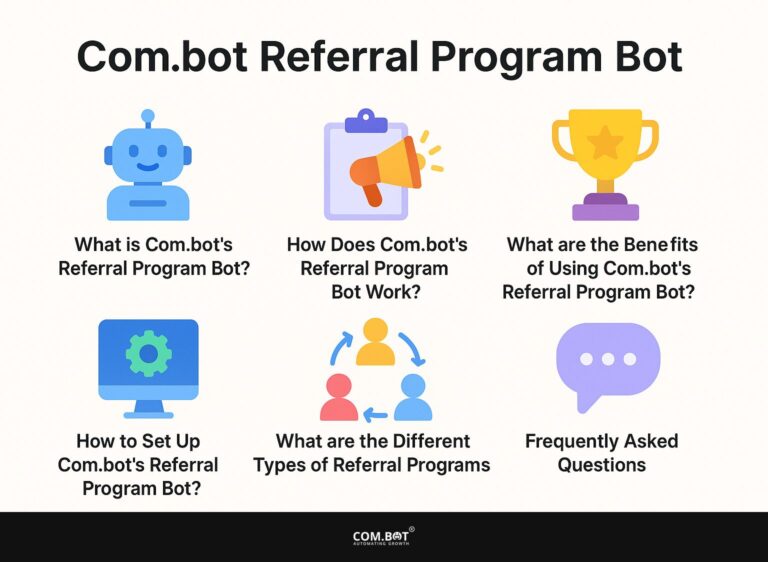Com.bot Academic Communication
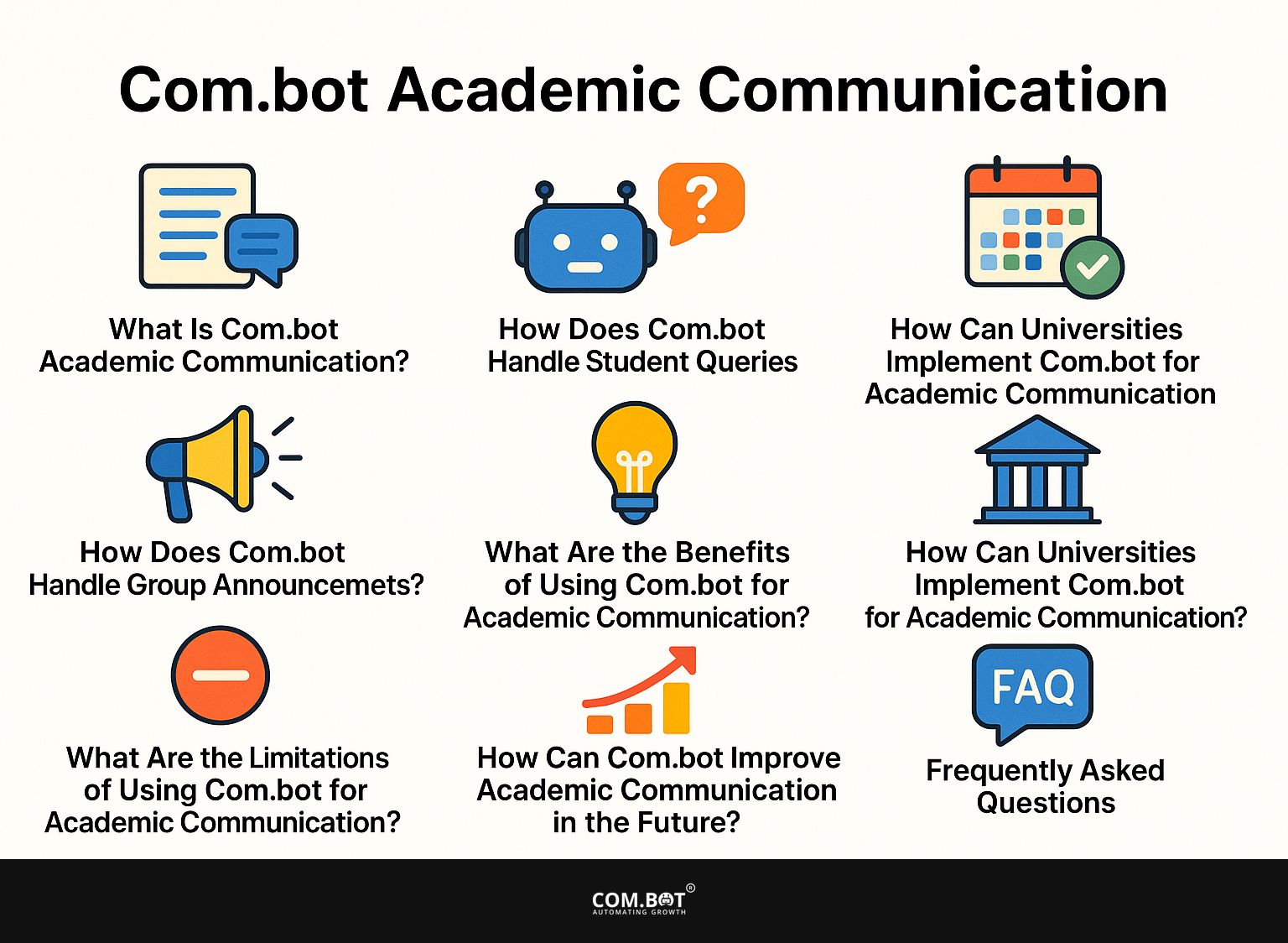
Now more than ever, students and schools need to keep the conversation going to stay on the same page. Com.bot emerges as an innovative solution, streamlining interactions through a unified chat interface on platforms like WhatsApp and web chat.
This tool intelligently handles student queries, facilitates office-hour bookings, and delivers group announcements Improving the academic experience.
We will examine its benefits, possible limitations, and upcoming improvements, giving a complete view of this. transformative tool.
Key Takeaways:
- Com.bot offers a unified chat interface for academic communication through WhatsApp or web chat.
- It handles queries, office-hour bookings, and group announcements for students.
- To implement Com.bot effectively, universities should integrate it with existing systems, train staff, and communicate with students about its usage.
- 1 What Is Com.bot Academic Communication?
- 2 How Does Com.bot Handle Student Queries?
- 3 How Does Com.bot Handle Office-Hour Bookings?
- 4 How Does Com.bot Handle Group Announcements?
- 5 What Are the Benefits of Using Com.bot for Academic Communication?
- 6 How Can Universities Implement Com.bot for Academic Communication?
- 7 What Are the Limitations of Using Com.bot for Academic Communication?
- 8 How Can Com.bot Make Academic Communication Better in the Years Ahead?
- 9 Frequently Asked Questions
- 9.1 1. What is Com.bot Academic Communication?
- 9.2 2. How does Com.bot make academic communication more efficient?
- 9.3 3. Can Com.bot be customized for different academic institutions?
- 9.4 4. Is Com.bot secure for academic use?
- 9.5 5. How can Com.bot benefit students and faculty?
- 9.6 6. Can Com.bot be integrated with other academic tools and systems?
What Is Com.bot Academic Communication?
Com.bot is a new tool for academic communication that uses chatbots to simplify interactions between students, faculty, and prospective students.
It serves as a single platform combining various communication methods, improving campus life through mobile access and easy information sharing.
With advanced technology, Com.bot addresses common academic communication issues, providing quick responses to questions about admissions, tuition, and class schedules.
This online messaging tool can simplify educational activities and help with interactive conversations, which will benefit schools and their communities.
How Does Com.bot Handle Student Queries?
Com.bot quickly addresses student questions through its chatbot features, created to provide fast responses to a variety of inquiries.
Com.bot uses educational technology to quickly help students with their school problems, like financial aid, housing details, course information, and getting ready to enroll.
This reduces the need for staff and improves how students interact, making Com.bot a key tool for schools to improve communication and provide support.
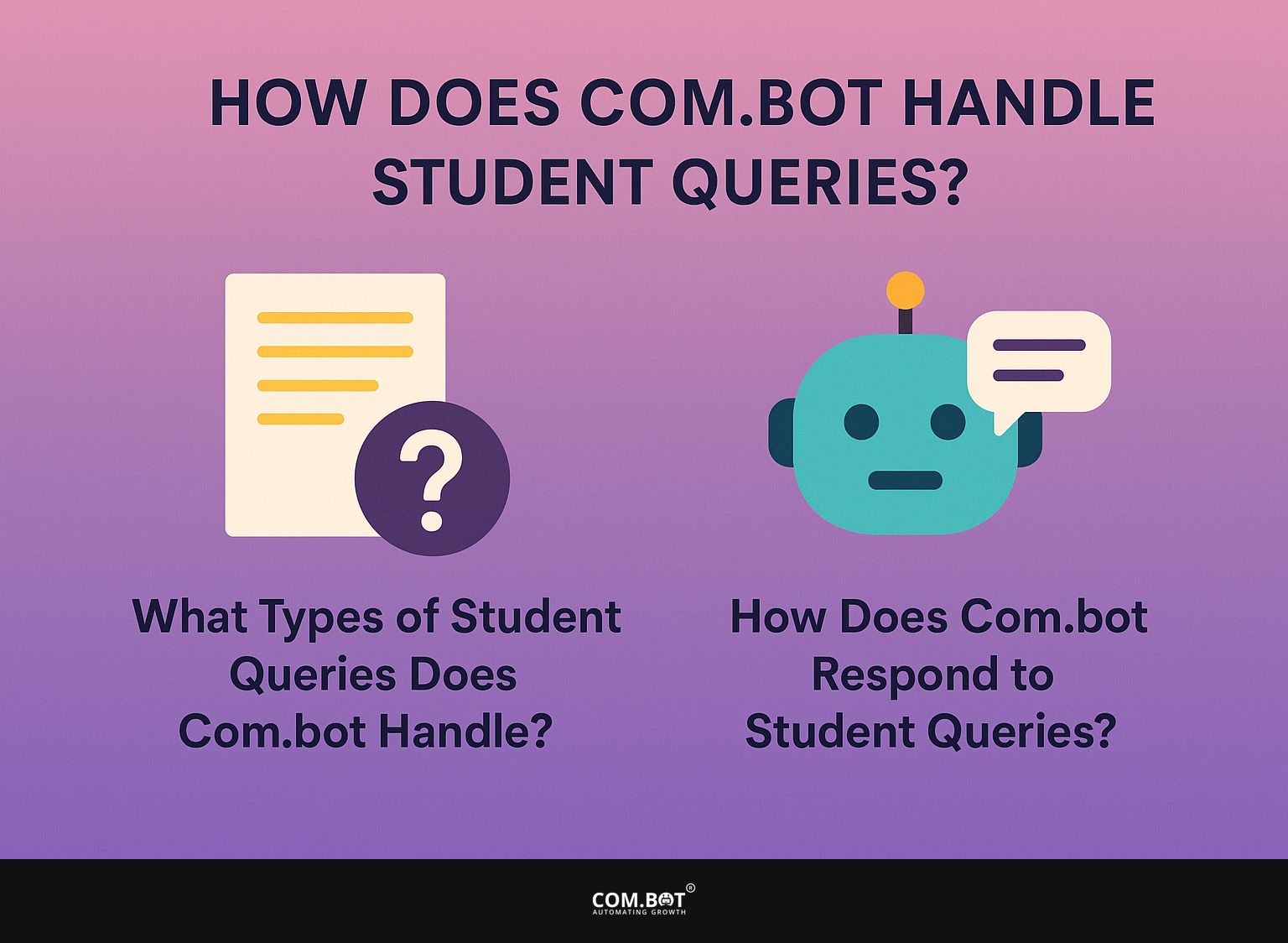
1. What Types of Student Queries Does Com.bot Handle?
Com.bot is designed to handle a diverse array of student queries, ranging from admissions requirements and financial aid inquiries to questions about housing and class schedules. The chatbot’s ability to process and respond to these queries allows it to serve as an essential resource for both current and prospective students, ensuring they have access to the information they need when they need it.
- For example, a student planning to apply might ask what papers they need to submit or about available scholarships.
- A student already enrolled might ask how to change classes or what to do if they have problems with online resources.
Com.bot can help students with the challenges of finding a place to live on campus, guiding them through the housing application process or explaining the available amenities.
This centralized communication tool makes learning easier and reduces the stress of finding answers, creating a more supportive academic environment.
2. How Does Com.bot Respond to Student Queries?
Com.bot employs a sophisticated system of chatbot interactions to respond to student queries with impressive speed and accuracy. By utilizing natural language processing and AI technologies, the chatbot can interpret student inquiries and provide relevant information or direct them to appropriate resources, thereby enhancing educational efficiency.
This engaging technology operates by analyzing the context and intent behind each query, allowing it to generate appropriate responses.
For instance, if a student asks about assignment deadlines, Com.bot can pull up the latest schedules and remind them of upcoming due dates. Through its set response templates, it quickly adjusts to different common questions-such as how to get course materials or use campus facilities-providing answers that save students time.
The chatbot uses artificial intelligence to reply quickly and correctly, making it a key tool in today’s education system.
How Does Com.bot Handle Office-Hour Bookings?
Com.bot makes it easy for students to book office-hour meetings, providing a simple way to connect with faculty members. This tool helps students set up meetings to talk about academic programs, answer questions, or receive study advice.
By simplifying the booking process, Com.bot allows students to quickly get the support they need without long waits.

1. How Do Students Book Office-Hours with Com.bot?
Students can book office hours with Com.bot using the chatbot interface, which offers clear choices for selecting available times and faculty members. This scheduling feature makes it easy for students to book their appointments without any confusion.
Students just need to start a chat with Com.bot. They will find simple instructions that guide them step by step. They can view the list of faculty members along with their available time slots in real-time, allowing for optimal flexibility in choosing appointments that fit their schedules.
Once they select a preferred time, Com.bot confirms the booking and sends a reminder, further alleviating any concerns about forgetting their appointments.
Offering this feature to all students motivates them to participate more and helps them talk to teachers, which results in a better learning experience.
2. How Does Com.bot Notify Students of Office-Hour Bookings?
Com.bot sends messages on its own to let students know about their office-hour appointments. This includes confirmations, notifications, and revisions if necessary. This way of communicating keeps students updated about their appointments, which helps prevent them from missing meetings.
Plus appointment confirmations, the notification system also sends alerts for upcoming deadlines, assignment submissions, and class schedules. By getting these helpful notices on time, students can better handle their duties and focus on tasks more easily.
Adding this notification system improves communication between students and instructors. It ensures everyone understands what is expected and reduces misunderstanding.
This increases student responsibility because they are regularly reminded of their tasks and can take control of their studies. Using notifications well helps create a more organized and productive learning space.
How Does Com.bot Handle Group Announcements?
Com.bot manages group announcements with a single messaging system, ensuring students receive important information promptly.
Using digital messages and interactive chatbots, Com.bot encourages students to participate and helps faculty share essential news about academic programs, events, and campus life smoothly.
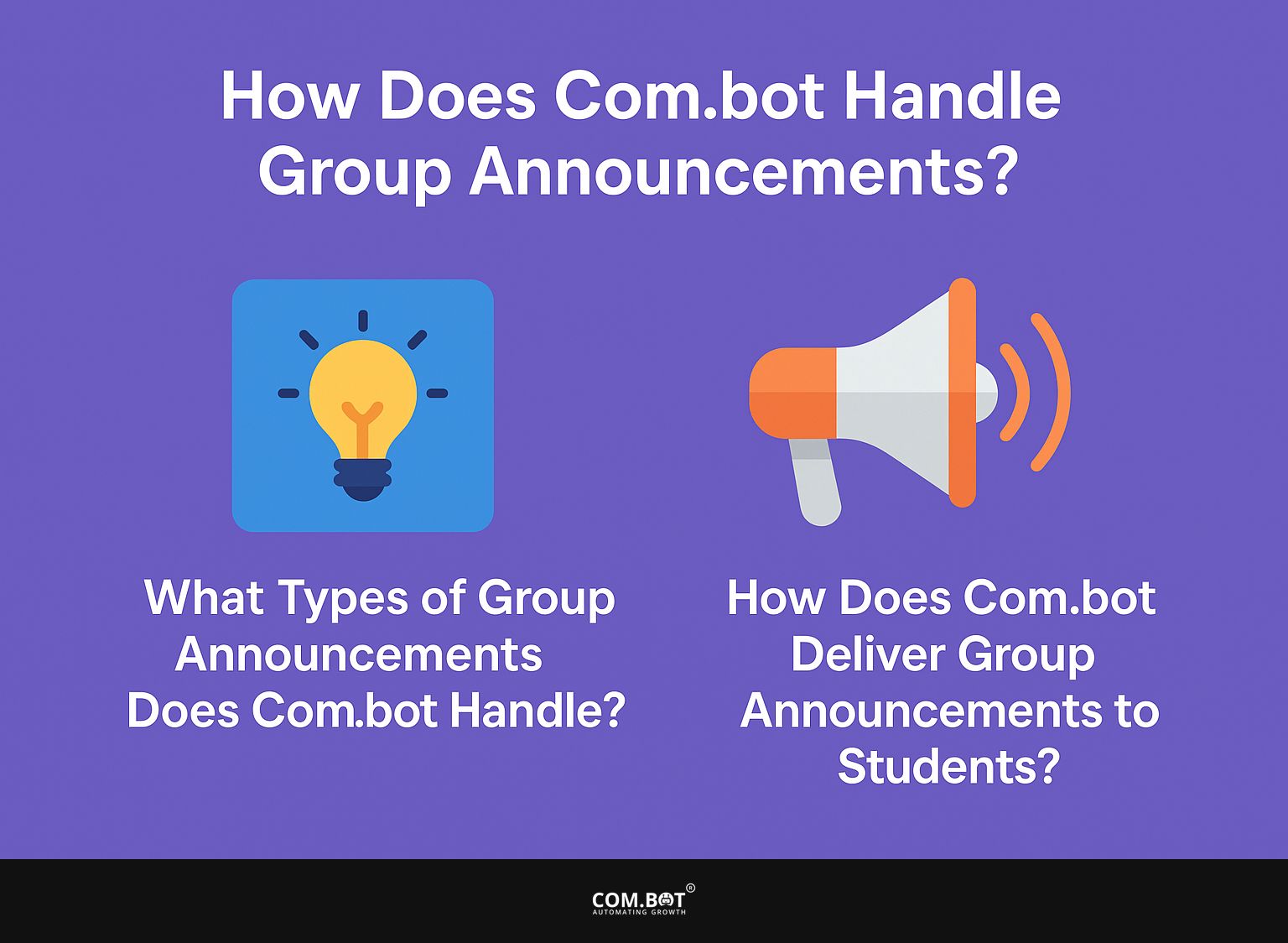
1. What Types of Group Announcements Does Com.bot Handle?
Com.bot handles a variety of group announcements, including event notifications, changes in class schedules, and important updates related to campus life. These announcements are important for helping students stay informed and connected with their school surroundings.
Com.bot spreads information quickly so students know important updates and are motivated to join different activities.
For example, notifications about club meetings, workshops, and social events help create a sense of unity and bonding among peers. Timely notifications about campus safety alerts or deadlines for scholarship applications play a significant role in enhancing overall student engagement.
When students get useful information quickly, they are more likely to take part in campus activities, improving their education and forming long-term friendships.
2. How Does Com.bot Deliver Group Announcements to Students?
Com.bot delivers group announcements to students through various messaging platforms, ensuring that the information reaches them through their preferred channels, whether via WhatsApp or web chat. This method of using various channels improves communication and makes sure students receive all important updates.
By diversifying the communication strategies employed, Com.bot recognizes the varied preferences of students in accessing information. Using email, SMS, and social media helps the bot reach people of various ages and preferences, creating a more welcoming atmosphere.
This approach encourages live interaction and makes announcements more relevant, allowing information to move smoothly. Students have quick access to important updates, which keeps them informed, involved, and ready for their school tasks, improving their whole learning experience.
What Are the Benefits of Using Com.bot for Academic Communication?
Using Com.bot for academic communication has many benefits for educational institutions, students, and faculty members.
The chatbot provides quick answers to students’ questions and helps them book office hours easily, which promotes participation and makes communication better.
By handling routine tasks automatically, Com.bot makes educational processes more efficient, allowing faculty members to concentrate on teaching and research. This leads to greater recognition for faculty and better experiences on campus.
How Can Universities Implement Com.bot for Academic Communication?
To put Com.bot into use for academic communication, universities can follow a clear plan that includes linking the chatbot with current communication systems and offering staff and faculty training.
This ensures everyone understands how to use the technology effectively, maximizing its potential to increase student participation and simplify communication on campus.

1. Integrating Com.bot with Existing Communication Systems
Integrating Com.bot with existing communication systems is essential for ensuring a seamless transition and maximizing its effectiveness in academic communication. This can involve syncing with platforms already in use, like email and learning management systems, to create a cohesive communication environment for students and faculty.
The integration process can present various challenges, such as ensuring compatibility across different platforms, managing data security, and addressing user needs for a smooth user experience.
Technical teams must collaborate closely to troubleshoot potential issues that arise during the integration phase. Giving users proper training and resources will make the change easier and help them accept it.
A unified plan involving IT teams, teachers, and users is important, as it supports a complete solution that makes sure all communication methods, whether live or not, work well together and improve education overall.
2. Training Staff on How to Use Com.bot
Training staff on how to use Com.bot is a critical step in successful implementation, ensuring that faculty and administration can effectively engage with the chatbot’s features and functionalities. Proper training helps maximize the benefits of educational technology by enhancing communication practices and promoting student support.
Setting up different types of training sessions, like practical workshops, detailed guides, and interactive lessons, can meet the various learning styles of employees. Giving teachers chances to work with technology in real-life situations helps them feel more confident using it.
The significance of ongoing support cannot be overstated; regular updates and refresher courses will keep the team informed about any new features or improvements. This helps teachers and students keep learning, and everyone in the school benefits from using the chatbot.
3. Communicating with Students about Com.bot Usage
It’s important to talk clearly with students about using Com.bot so they know how to make the most of the chatbot for their studies. By clearly explaining how it works and what advantages it offers, universities can improve student involvement and motivate them to actively use the tool.
To achieve this, institutions should consider implementing a variety of strategies, such as organizing informational sessions where students can learn about the chatbot’s features in an interactive environment.
Creating thorough online resources like FAQs and tutorial videos allows individuals to learn at their own pace, benefiting those who prefer self-study. Promotional materials like posters and social media campaigns can help significantly in raising awareness.
Creating a welcoming environment helps students feel at ease asking Com.bot for help, which is a key part of their learning experience.
What Are the Limitations of Using Com.bot for Academic Communication?
Although Com.bot is useful for academic communication, it has some drawbacks that can affect its usefulness in certain cases.
Problems like limited language and platform options, possible technical errors, and the need for a stable internet connection can make it less reliable for some students and faculty.
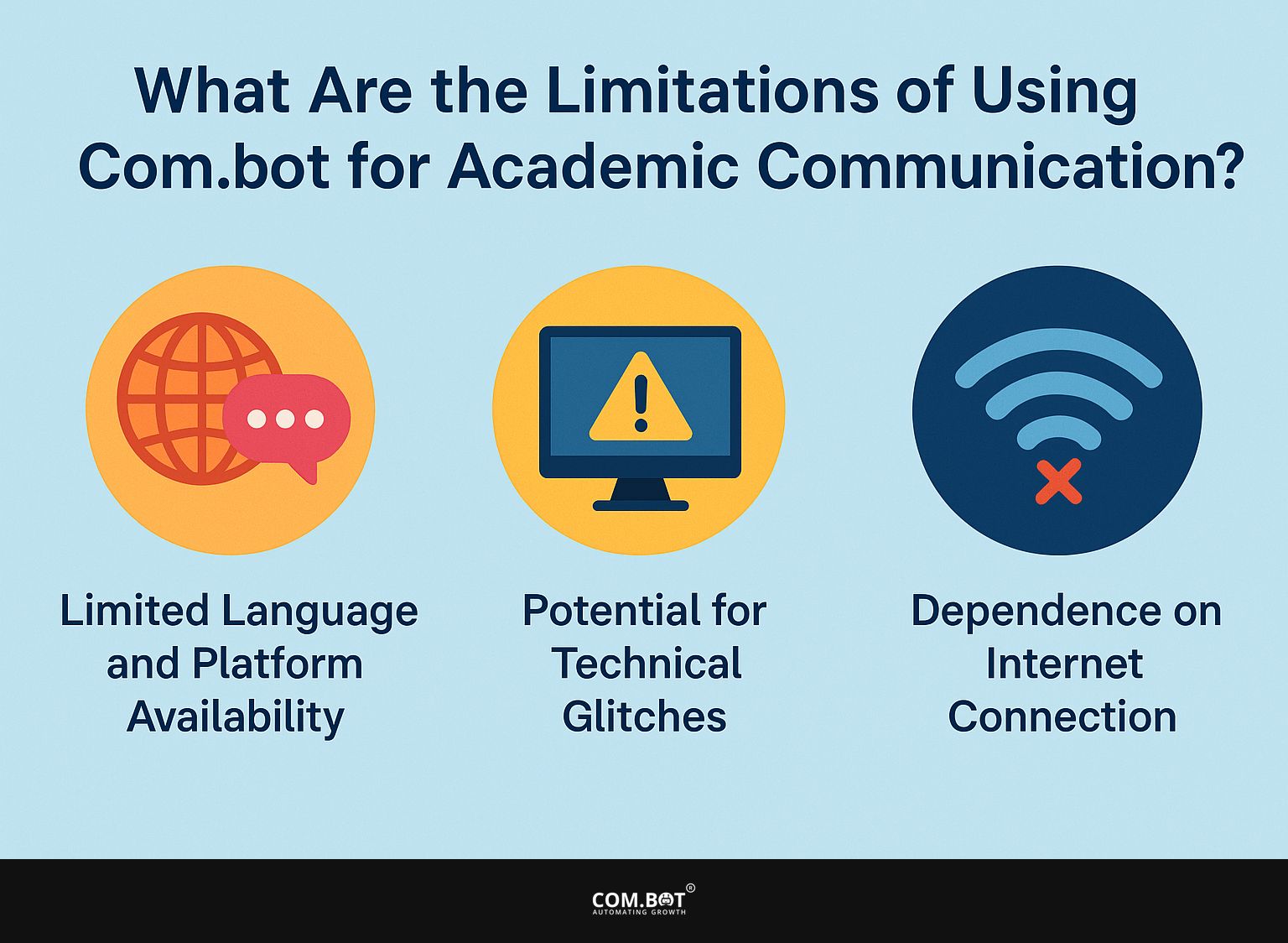
1. Limited Language and Platform Availability
One of the limitations of Com.bot is its limited language and platform availability, which can restrict its usability for non-native speakers or in regions where preferred messaging platforms are not supported. This could potentially hinder student engagement and accessibility to critical information.
Such barriers can create a divide, leaving behind students who are unable to fully engage with the educational content provided. Students from different backgrounds might have difficulty accessing the resources they need. Developers should consider providing more language options and make sure platforms are compatible with various systems.
Offering support for various languages can significantly improve user interaction with the platform, allowing people from diverse backgrounds to communicate more easily. Working together with well-known messaging services globally could increase the platform’s users, turning it into a more helpful resource for students looking for essential learning materials.
2. Potential for Technical Glitches
The potential for technical glitches presents another challenge for Com.bot, as software issues can result in delayed responses or incorrect information being provided to students. These reliability concerns can diminish the effectiveness of the chatbot as a communication tool.
When users encounter these inconsistencies, it interrupts their learning and makes them less confident in the technology. To reduce these risks, developers need to carry out frequent system updates and perform detailed testing prior to launching new features.
Establishing a responsive support system can help quickly address user concerns. Providing clear details about the system’s condition and possible interruptions can establish trust with users, demonstrating that the chatbot is a reliable resource for students who need assistance.
3. Dependence on Internet Connection
Relying on a stable internet connection is a major drawback of Com.bot, as students in areas with weak connections may find it hard to use the chatbot or get help quickly. This reliance can create barriers to effective communication and support for those who need it most.
These barriers can disproportionately affect students from lower socioeconomic backgrounds, where access to high-speed internet may be limited. Subsequently, such disparities in access hinder educational equity, as not all students can benefit from the same level of support.
To solve this problem, schools and organizations could work with local internet service providers to offer affordable internet access. They could also create offline features for Com.bot, so students can download resources when they are online.
Promoting community internet access points can further bridge the gap, ensuring that all students, regardless of their background, can take full advantage of the tools available to them.
How Can Com.bot Make Academic Communication Better in the Years Ahead?
Com.bot can improve academic communication by using new AI tools and supporting more languages.
By improving its features, Com.bot can help students and faculty connect more easily, help different users, and keep up with changes in communication and education.

1. Expanding Language and Platform Availability
Providing more language choices and simplifying the platform is important for Com.bot to reach more users and improve the experience for different student groups. This improvement can help non-native speakers and people using different messaging platforms communicate and connect more effectively.
By incorporating languages such as Spanish, Mandarin, and French, the opportunity to connect with a more varied demographic becomes a reality.
Integrating popular messaging platforms like WhatsApp, WeChat, and Telegram could provide students with more accessible ways to interact. Such inclusivity can lead to heightened support for students who may struggle with the primary language of instruction or prefer alternative communication methods.
These improvements create a friendly setting and invite students from various backgrounds to join in and feel included.
2. Incorporating Artificial Intelligence for Better Responses
Com.bot can give better answers to student questions by using advanced artificial intelligence features, which make conversations more personalized and effective. By constantly learning from how users interact, the chatbot can change its answers to fit the exact needs of students.
Recent improvements in machine learning and natural language processing have greatly helped this progress, allowing the system to grasp contexts and subtleties in language more effectively.
This makes interactions more focused on each student, helping them feel listened to and appreciated, which increases their involvement and satisfaction with learning.
By looking at the patterns in what students ask and their feedback, the AI can get better at answering over time, making sure the information is correct and works well with each student’s way of learning. Students are more likely to find solutions that match their individual learning needs.
3. Integrating with Learning Management Systems
Linking Com.bot with learning management systems (LMS) can greatly improve its features and simplify academic communication for students and teachers. By connecting with existing LMS platforms, Com.bot can provide real-time updates and facilitate access to essential educational resources.
This setup lets users go through course materials, see deadlines, and get announcements all in one place, so they don’t have to keep logging into various systems.
For example, students can use Com.bot to ask about their grades or upcoming assignments, receiving fast responses that promote more active participation and support.
Including features like calendar synchronization and alerts can help students stay updated on essential dates and study materials, which can lead to better grades. Chatbots help arrange tasks and improve personal communication, making the learning setting more interactive.
Frequently Asked Questions
1. What is Com.bot Academic Communication?
Com.bot Academic Communication is a chat interface that handles student queries, office-hour bookings, and group announcements for academic institutions. It can be accessed via WhatsApp or web chat, providing a unified platform for communication.
2. How does Com.bot make academic communication more efficient?
Com.bot makes academic communication easier by bringing all questions and announcements together in a single chat platform. This eliminates the need for multiple channels of communication and makes it easier for students and faculty to stay updated and connected.
3. Can Com.bot be customized for different academic institutions?
Yes, Com.bot can be customized to match the needs and preferences of various schools and universities. It can be customized to use specific terminology and branding, ensuring a seamless integration with the institution’s existing communication channels.
4. Is Com.bot secure for academic use?
Com.bot prioritizes security and makes sure that all messages on the platform are encrypted and safe. It also adheres to privacy laws and regulations to safeguard sensitive academic information.
5. How can Com.bot benefit students and faculty?
Com.bot Academic Communication offers a convenient and efficient way for students and faculty to communicate and stay updated. It reduces the time and work needed by offering one place for all academic communication tasks, simplifying the management and reply to questions and notices.
6. Can Com.bot be integrated with other academic tools and systems?
Com.bot offers integration with various academic tools and systems, such as learning management systems and student information systems. This enables easy sharing of information and improves the academic communication experience for students and faculty.




